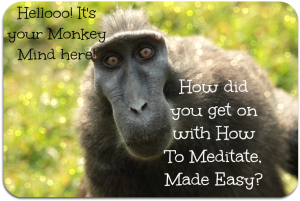Mindfulness is a way of bring our over-full mind back from wherever it has been camping out, to living in the present moment. It can be an incredibly useful technique for dealing with stress and worries, as well as for deepening your meditation experience.
Discover how mindfulness can help you get out of ‘auto-pilot’ mode and reclaim your choice over how you respond to challenging events and experience life.
Being mindful is about a state of being – a particular way of choosing to experience life, in the present moment – rather than letting our mind run riot over past mistakes and future worries, whilst sleep-walking through what’s actually going on around us.
We’re normally too busy doing “mind-full” to be mindful.
 We are usually far too busy running around doing stuff, to actually notice what we’re experiencing.
We are usually far too busy running around doing stuff, to actually notice what we’re experiencing.
We’re part of a constant, fast-flowing stream of cause and effect – buffeted by the proverbial tides, reacting, reacting, reacting.
Often we don’t even notice that we’re stuck in this cycle, running in circles like an over-enthusiastic gerbil in a plastic wheel. We want to be in control of things, so we develop stress-based behaviours to get things back under control, but that rarely works because we’re still too busy reacting. We try harder and harder, but life still seems to be a like a game of skipping through treacle.
We change our experience of life by changing the way we see the world.
Being mindful means dragging ourselves back into the present moment – away from the “to do” list, the housework, Aunty Bettie’s birthday card and everything else that normally fills our mind to bursting point.
We might think that being present to the moment will mean that the “to do” list will get forgotten and the shopping won’t get done. But, in fact, it’s the other way round.
By focussing our experience right now, rather than dwelling on past issues or worrying about the future, we can develop a clarity that somehow creates more time in our day, meaning the “to do” list finally gets shorter.
By getting back into the “now”, we can start to reconnect with the part of us that makes the unconscious choices about how to think, feel and act, in every single moment.
We also get our thoughts, feelings and actions back under conscious control, breaking long-held habits of automatic responses to what psychologists call “stimuli”, but the rest of us call “difficult people”.
Here are four steps that demonstrate the magic of mindfulness:
- There’s always a gap between the other person’s “stimulus” and our response
It’s a chemical, biological fact that there is a time gap between our brain receiving a “stimulus” and us responding.
It might be very short, but by being mindful – aware – more of the time, we can become aware of that gap and….
.- … When we can get in the gap, we can choose
Although some habits run deep, we always have a choice about how we respond.
Though most of us believe that others can make us happy or angry, all they can do is provide the stimulus for us to choose that emotion as our response.
In fact, the only place we can choose is in the gap. The past is gone and the future hasn’t been created yet. All our power is right here, right now.
.- Our choices have a big impact
You can’t change the other person, but you can always choose how you respond.
And if you have jumped into the gap and made a more resourceful, conscious choice, then you can break the cycle – the cause & effect dance – and provide a more constructive stimulus to which the other person can then respond.
.- We can only make a choice if we have awareness
If we’re on auto-pilot and are bobbing around on an ocean full of emotions and habits like an inflatable dinghy in a storm, then we’re unlikely to spot what’s really going on.
We’re probably enjoying our own projection of the “facts”, telling the story “our way” in our head. The fact is that, if we’re wandering around half-asleep and unaware, we’re not going to be able to make a conscious choice about how to respond.
Unfortunately we are usually half-asleep or stuck in our “story heads”, most of the time.
We can be in a beautiful location, but almost not notice it, because we’re too busy wondering whether an urgent email has arrived or stressing about how last week’s presentation went.
That’s why it’s so useful to have specific mindfulness exercises to practise, to help us retrain ourselves to live more often in the here and now.
There are plenty of good books out there on mindfulness, but by far the best way to learn it is to join a course with an experienced teacher.
Want to learn how to meditate?
If you don’t have one of those local to you, you might like to join in with one of my online meditation courses. If you just want to try out meditation, to see if it works for you, then you’ll love my free 7 day beginners’ guide: How To Meditate, Made Easy.
If you want to dive in and truly discover how 10 minutes a day of meditation can change your life, then you won’t want to miss How To Meditate (And Change Your Life)!
It might sound unbelievable, but 10 minutes a day of meditation can change your life. 🙂

